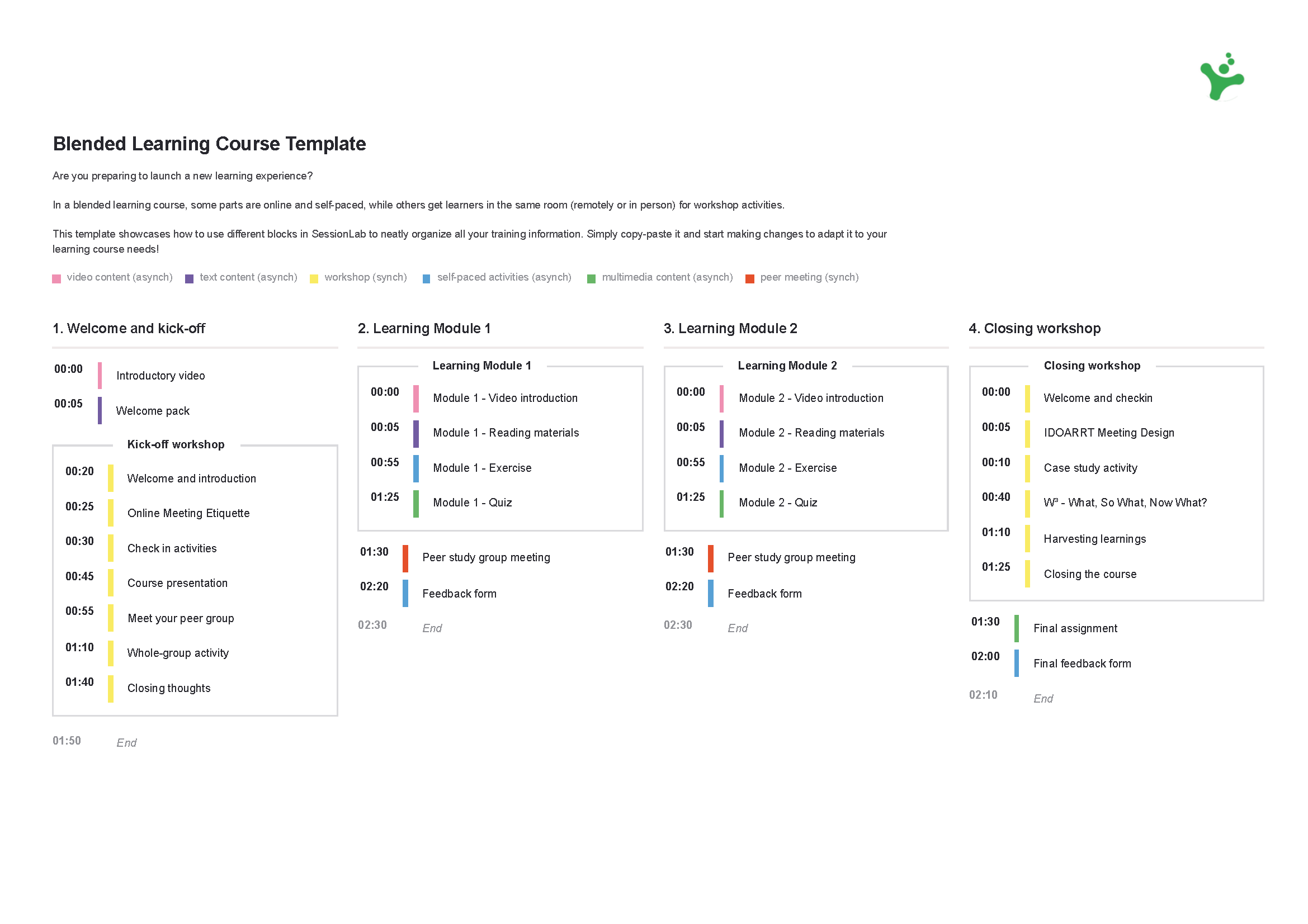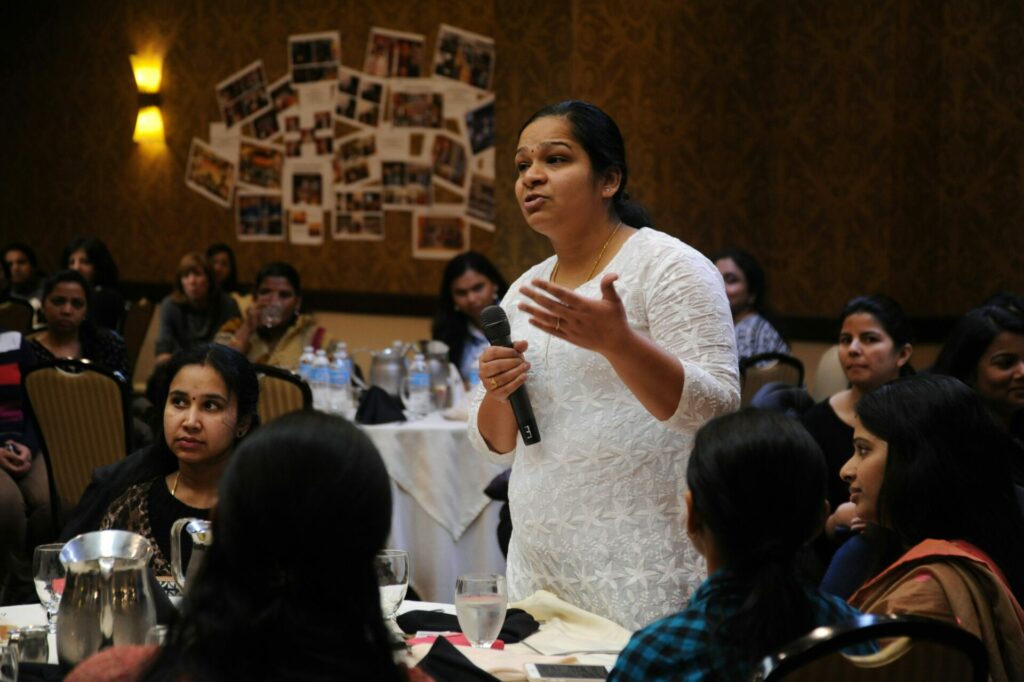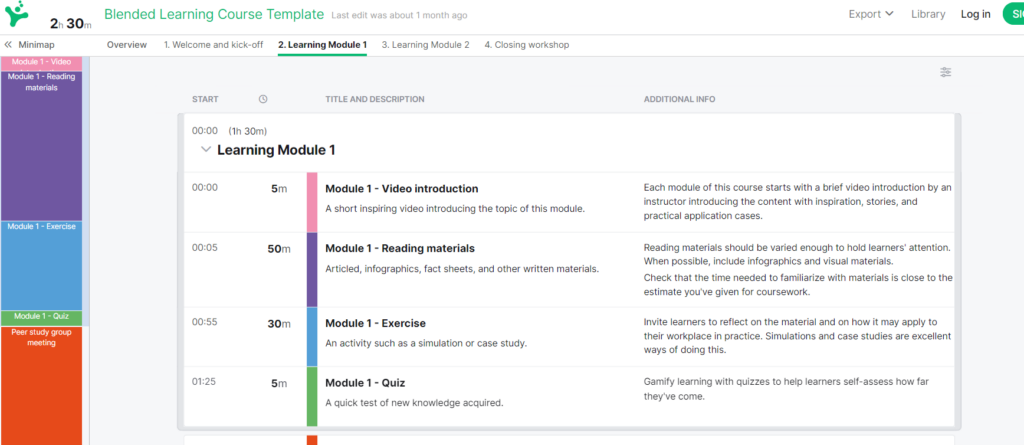How to Master Blended Learning Design (for Learning that Sticks!)

Blended learning design has emerged as a key trend in education in the post-pandemic world. It means creating courses that combine elements of asynchronous and synchronous learning.
Parts of the course's learning activities will be accessible to learners as online resources. Others will be delivered synchronously, which might mean in person or through online workshops.
Even for expert trainers and learning designers, developing a blended learning course can be a daunting experience. Combining such disparate elements in a coherent whole that leverages the best of each, for learning that sticks, requires thoughtful planning and design.
In this article, we’ll look at the key elements for creating excellent blended learning experiences. Read on for practical tips and tricks, ideas and recommendations on avoiding possible pitfalls. We will cover:
What is a Blended Course?
Blended learning courses are training and education experiences that combine different elements, leveraging the power of both synchronous and asynchronous study opportunities.
Barely existing before the Covid-19 pandemic, blended learning spaces are now a growing trend. The reasons are quite straightforward: the training community is now very well aware of the advantages offered by online, self-paced learning (such as MOOCs, Massive Open Online Courses). Content can be hosted online and accessed by learners at their convenience, offering much-needed flexibility.
At the same time, it’s well known that direct interactions with peers and instructors are irreplaceable elements for learning that sticks. Blended courses designed by learning designers bring together the best of both worlds.
There are four possible components to a blended course.
- Asynchronous, self-paced learning modules. Self-paced study resources, such as videos and articles, give learners the flexibility to study when it works for them, and return to materials at any time.
- Small group work. Working through assignments in a group of peers is a strong motivator, which is likely to increase retention and boost learning. We will see below how this can be organized, depending on the type of course you are designing.
- Synchronous workshops, online. Participatory workshops held on online platforms are a versatile container for learning activities. These can combine plenary work, guided individual reflection, and discussion in breakout rooms (Looking for more information on how to hold engaging workshops for online learning? Here is a dedicated guide).
- Synchronous, face to face sessions. If your course is designed for a specific company, or perhaps for a University, it may allow for participants to gather in person. We’ll see below how to make the most of this opportunity!
Not all blended courses will include all components, as the mix greatly depends on the specific circumstances. Having at least one synchronous and one asynchronous element is what makes it a blended learning space. You can see an example of how this might fit together in this blended learning course template.
In the next paragraphs we’ll look into each modality in turn. But first, allow me to share a personal story.

A Real-world Example of Blended Learning
My experience with blended learning environments comes from working as a group coach for various cohorts of Masters’ students enrolled in the EIT Climate-KIC’s education programs.
Traditionally held only in-person, these programs had to undergo a quick, radical restructuring due to the Covid-19 restrictions of 2020 and 2021. In 2020, the program was moved fully online but remained completely synchronous, with participants joining from all over the world to online workshops and lectures, held on Zoom.
Having kept our poor students (as well as ourselves!) hostage too many hours in front of the screen, we quickly learnt that online participation could be leveraged to give more flexibility to learners.
The 2021 program was therefore re-designed, this time as a blended learning environment. Our main objective was to design online learning activities that would encourage strong connections among participants, adding many opportunities for online interactions.
We achieved this with a combination of
- large, online, in-sync workshops, where 200+ participants joined at the same time, working on vast Miro whiteboards, listening to inspirational speakers, and going through a variety of online learning activities;
- intimate, 8-people cohorts that met on Zoom once every two weeks with a coach to work through specific parts of the program and support one another’s motivation and learning process.
The rest of the program was based on self-study, with modules including online resources such as reading materials, videos, and individual exercises, particularly journaling.
In 2022, the program moved back to a mainly in-person, live environment. As designers and education specialists, we met o discuss whether we should keep any elements of the previous blended learning environment.
We concluded that online work was extremely supportive of the in-person section, enabling participants to e-meet before meeting in the classroom, explore topics, and start forming a group spirit.
After the in-person component, we designed modules that allow participants to dig deeper into topics of their choice, and online workshops to keep in touch and keep learning together long after the events were over.
Why Learners Love Blended Training
As I learned when designing blended learning programs for our students, participants get a lot of benefits from blended training. Essentially, it allows to get the best of both worlds: the flexibility and depth afforded by self-paced learning, and the cohesiveness, networking opportunities, and shared space for reflection that comes with live interactions.
Research shows that the absence of learner interaction causes failure and eventual drop-out in online courses and the lack of learner connectedness was noted as an internal factor leading to learner drop-out in online courses.
Blended learning effectiveness: the relationship between student characteristics, design features and outcomes
As noted in the above quote from this intriguing paper published in the International Journal of Educational Technology in Higher Education, failure in online courses stems most often from the absence of opportunities for interaction among peers and with instructors.
Blended learning, by contrast, includes many different opportunities for online and face-to-face training activities that strengthen connectedness and support the learning process.
How to Combine Synchronous and Async Elements for Blended Learning
Each element of a blended learning course serves different purposes. As designers of such courses, it’s important to have clarity about what works well, using each format to support learning in such a way as to have them strengthen each other.
Let’s go through them one by one and see what purposes they serve, and how they can work together to ensure your learning objectives are met.
Asynchronous, self-paced online learning
Self-paced online learning is individual work learners can do in their own time. From the designer’s point of view, this implies creating, selecting and developing online resources. These can include videos and reading material as well as exercises and worksheets for learners to work through individually.
To design modules for self-paced e-learning, you’ll need first to storyboard the flow of the course, then work with learning content providers to add videos, course content, presentations and activities. If you need some extra ideas on how to set up your workflow with all the right software tools, this article on instructional design software might help.
Great for: flexibility. Learners can study at their own pace, whenever is convenient. Well-designed self-study modules will also allow for different levels of exploration and depth, with the main content being the same for everyone but plenty of opportunities to dig deeper into specific facets of the subject.
Risk: it can be hard to sustain motivation if relying only on self-paced modules. Lack of feedback channels with other learners and with instructors mean it’s easy to get lost and give up.
How to use it: use self-paced e-learning modules to structure content, especially when it’s technical. Divide topics into easily digestible chunks, and lay it out clearly in your LMS (Learning Management System).

Small group work
Designing small group work into your blended learning course can be a challenge, but it’s certainly worth it. Here are some possible scenarios and ways you can set small groups up:
- In higher education, randomly place students in peer groups and provide them with group projects. Make sure you dedicate a live (online or face-to-face) session to setting up their groups and coaching them on how to work together, and give them precise milestones to achieve, step by step;
- In company trainings, it might be appropriate to have individual teams work through group assignments together, potentially with case studies that apply to them.
- Even in courses that are joined online by individual learners, it’s possible to get the benefits of small group work. One way of doing this, as is the case in my story below, is to invite participants to join as a small team of co-workers or friends. Another option is to randomly assign participants to a group (this latter option is only feasible if the course has a precise starting date by which all participants will be registered).
Great for: motivation. A small group setting is an excellent way to keep participants accountable. It doubles as a space for networking and creating connections.
Risk: small groups require a strong set of guidelines, especially at the start of their learning journey to work well.
How to use it: expect some fluctuating attendance and drop-outs, so make the groups a bit larger than you would in a face-to-face setting (think 5 to 8 people). Include a small group activity after each self-directed module.
As is wonderfully laid out in this case study from the BMC Medical Education journal, small group practice can degenerate into an unstructured, disorganized mess where a few earnest individuals end up doing all the work for everyone. Or it can be an uplifting, memorable experience of collaboration and learning.
Early in the Covid-19 lockdowns, I enrolled in a blended learning course hosted by Acumen Academy. I was encouraged to set up a study group, and since everyone was home trying to figure out how to live our lives in our living rooms, I easily persuaded five other facilitators to join.
We were encouraged to meet for a couple of hours online every two weeks, after each completing a course module individually. After our small group session, we each had to upload a finished worksheet with a group project to our LMS accounts, proving the session was complete, before moving on to the next module.
Although setting the actual time and date was left up to us (and was a scheduling challenge, I will not lie!), the rest of our work was carefully set up fro us with canvases, exercise sheets, and detailed session timelines. As someone who likes to learn in conversation with others, I have clear and crisp memories of our lively discussions and the online canvases we created and filled with virtual sticky notes.

Synchronous, online workshops
Include online workshops in your design as opportunities for learners to interact with content providers and peers. A virtual workshop can serve many different functions, including going through case studies, running role play activities, giving space in breakout rooms for discussions relative to the course content and Q&A sessions with speakers. In the context of a blended course, online workshops should not feel like lectures or webinars, but be truly interactive.
Great for: integrating course content into real-life scenarios, digesting and discussing content, exploring the topic with peers.
Risk: the use of technology tools such as whiteboards can pose an obstacle to participation. Make sure you have experienced virtual facilitators and tech hosts on board. Getting participants fully familiar with the technology you are using is key to making the experience useful and memorable.
How to use it: add online workshops at the start and end of the course. Repeat the same workshop more than once to ensure higher attendance.

How to add Live, In-Person Events to Your Blended Learning Design
Not every learning course can include live, face-to-face events. If you are having participants join from all over the world, for example, it’s extremely unlikely that everyone will gather in the same location at one point in time. That said, there are quite a few situations in which adding in-person events to your blended learning design is possible.
You might be designing training for a company that has a team retreat later in the year, which can be an opportunity to reflect and discuss the learning content. In higher education settings, it might be possible to launch an online learning course at the start of the school year face-to-face, or meet in the classroom every few months.
When people meet in face to face sessions, the amount of social interaction is much higher than in remote learning. Informal moments during coffee breaks can lead to unexpected outcomes, synchronicities, collaborations, and new ideas. Cohorts formed exclusively online tend to dissolve after the course is over, while people we’ve met in real life we might keep in touch with for years.
If you do have the luxury of adding face to face events to your design, you should make sure not to waste them!
Great for: creating momentum and enthusiasm. Networking. Supporting reflections, questions and feedback.
Risk: live events are more expensive and time-consuming to organize.
How to use it: add a face-to-face event at the beginning of your course to raise enthusiasm. If you have this component as well as small group work, make sure to dedicate some time during the live event for groups to meet and start organising their work together. If it’s possible based on your situation, add periodic face-to-face meetings with instructors and content providers for such activities as Q&A, role plays and simulations.
Don’t waste them in: lengthy presentations and “death by powerpoint” – you have so many more options of how to provide great content for your learners!

5 Tips (+1) for Designing Great Blended Learning Environments
Having established what the components of blended learning courses are, let’s look at some practical tips to keep in mind when working on the storyboarding and setup of such courses.
- Keep the sections straight in your head. It’s up to the designer to clearly establish what content will be delivered how, and how the various sections work together to achieve your learning objectives. Diagrams and schematics may help with this, as can a practical design tool such the ADDIE model for instructional design. You can also use the SessionLab app to keep the design clear and visually appealing.
- Use in-sync components to raise motivation, whether it’s big online workshops or small group work assignments. Dropouts are a big concern in online learning, and blended learning approaches can really help with this!
- Leverage the power of small groups. Research findings prove that small groups are the key to achieving learning outcomes. Design activities that groups can go through autonomously, give them team challenges and tools for collaborative learning.
- Provide opportunities for deeper dives. The main content for your self-paced online learning modules will be the same for everyone: keep it accessible, clear, and simple. At the same time, motivated learners will want to dig deeper into topics of their interest, so provide extra resources and specialized learning tracks;
- Give extra-clear instructions in your LMS. Blended learning courses have many moving parts and learners might get confused. What time is the online workshop? Do I need to attend? Create FAQ sheets and video explanations detailing the course structure. Have an email address or chat for participants to contact and make sure someone is answering. Don’t be afraid to repeat information twice (or more).
The last piece of advice I’ve got is rather controversial, so hear me out, and feel free to disagree in the comments:
- Don’t record live components. The most common questions you will get once the course is set up are probably going to be “Will you record the live sessions?” and “Where can I watch them?” Knowing that sessions will be recorded is bound to lower learners’ motivation to join, and we all know that watching a recording of a participatory workshop is no substitute for participation. Clarify that these are not lectures, and instead of providing recordings, repeat sessions more than once to accommodate different needs and time zones.
Start your Blended Learning Design from a Customizable Template
Now that you know more about the different elements that compose a blended learning course design, you probably have some ideas of how to put them together in a flow that works for your learners.
Starting and/or ending with synchronous sessions is a common format, as well as including small group work after every self-paced module.
Using SessionLab, you can easily visualize all the components, color-code them, and drag-and-drop elements to customize your design. To see what a blended learning course might look like, we’ve prepared this ready-to-use template.
This starter kit begins with an opening session designed to be hosted online, with the support of a facilitator well-versed in virtual workshops. It then contains two blank example modules to be filled with your content.
Each module ends with a small group session, and the entire course concludes with a synchronous reflection workshop where learners can have the opportunity to ask questions, think back on their learning and provide feedback. Find the complete template here!

In closing
Blended learning courses are a growing trend in education and elearning, both for higher education students and for professional training. I hope this article has equipped you with all the terminology and resources you need to design great blended learning courses with confidence!
Have you tried basing your design on our ready-made template? Have you used SessionLab for your blended course design? Do you agree that live sessions should not be recorded? Have we forgotten any important tips? Share in the comments and in our friendly online community!



Leave a Comment